A Guide to the Best Dog Harness for No Pulling
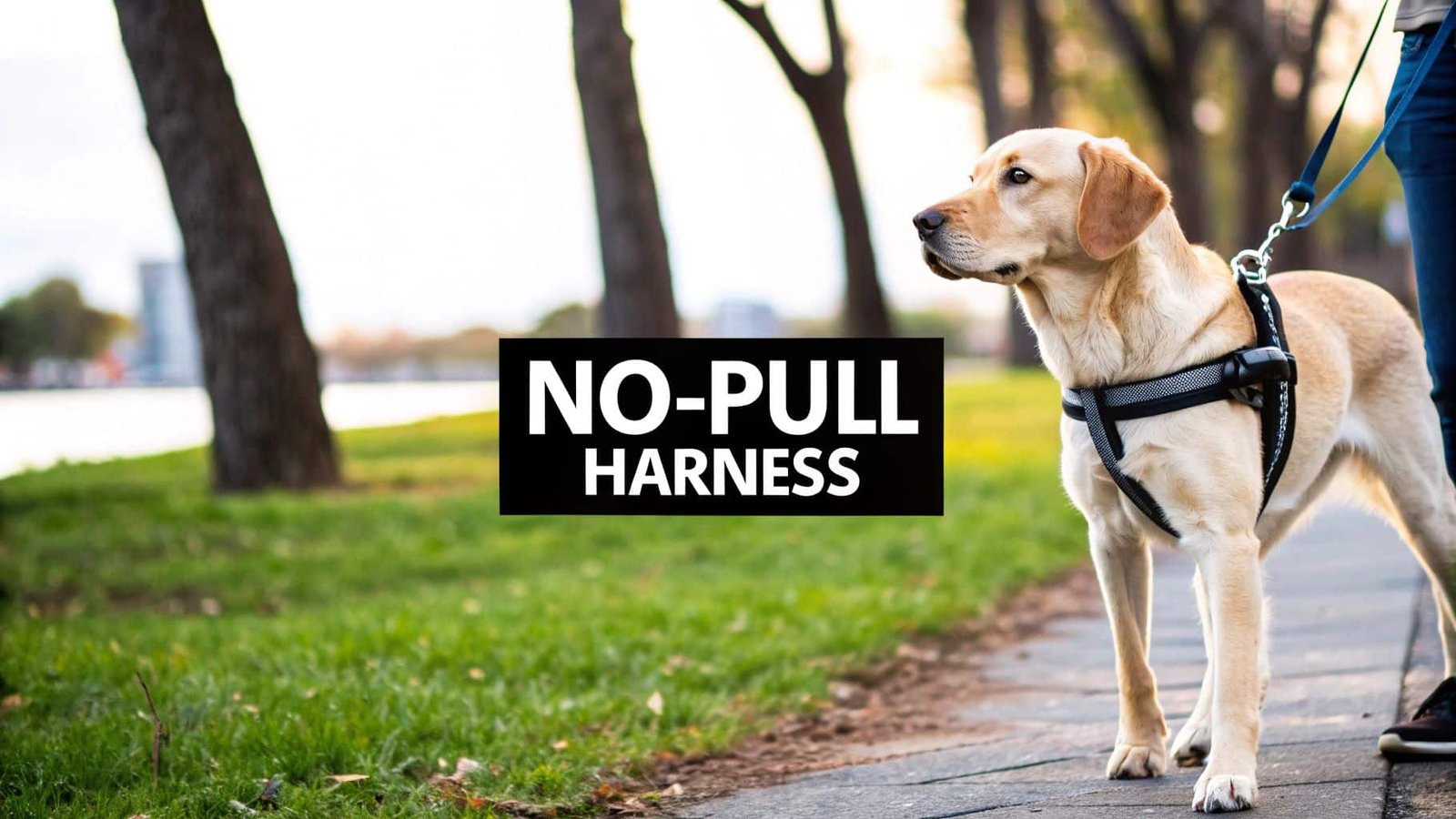
Tired of your daily walk feeling more like a tug-of-war? If your arm aches and you dread the sight of a squirrel, you’re not alone. That constant pulling isn’t just frustrating; it can put a dangerous amount of pressure on your dog’s neck and throat.
A dog harness for no pulling is designed to solve this exact problem. It’s a game-changing tool that works by cleverly redirecting your dog’s forward momentum. Instead of yanking on their neck, these harnesses typically have a leash clip on the chest, which gently turns your dog back toward you whenever they try to lunge ahead.
Your Guide to Happier Walks With a No-Pull Harness
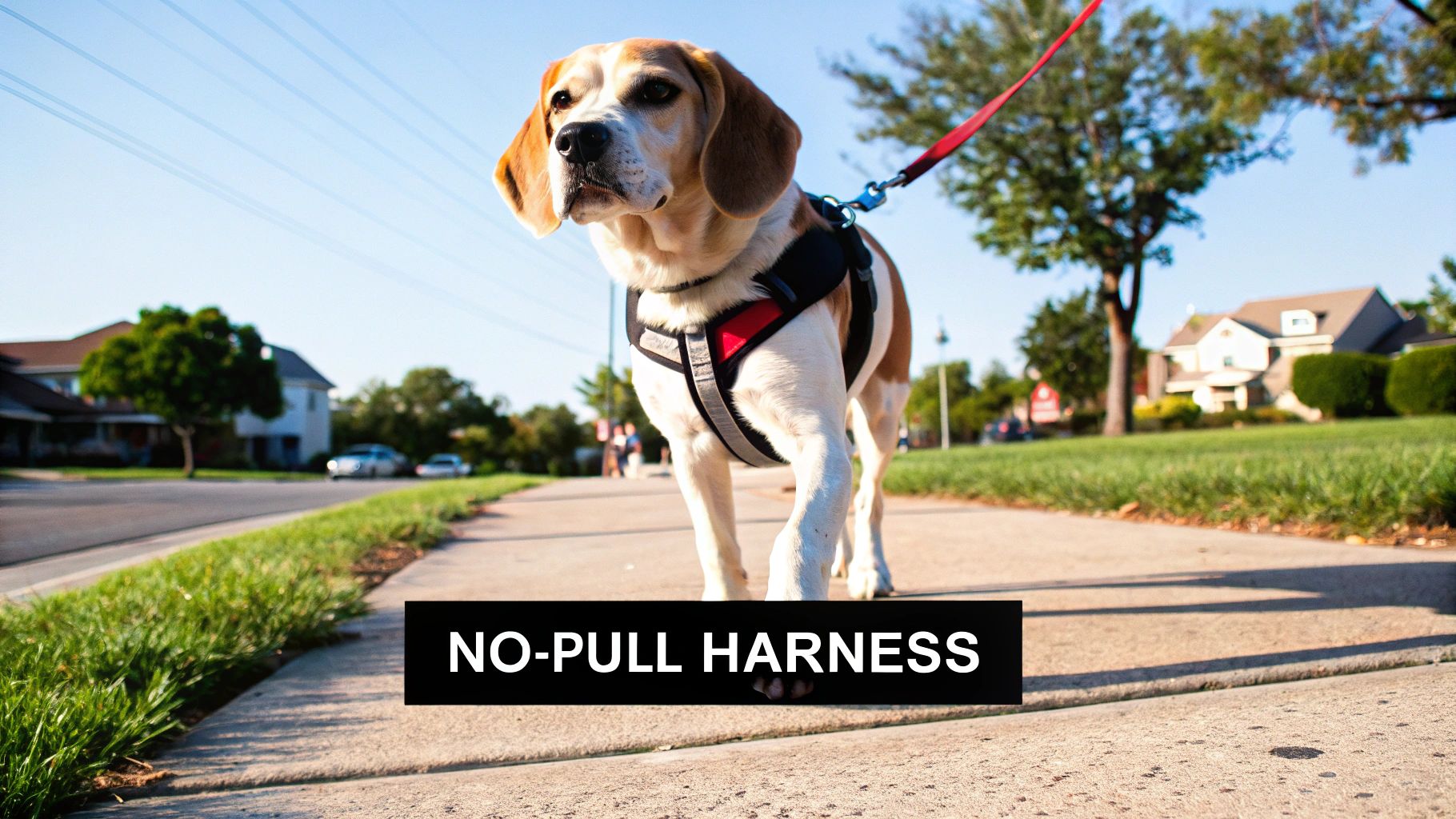
The daily walk is meant to be a high point for both you and your dog—a chance to bond, explore, and get some fresh air. But when you’re constantly battling a pulling dog, that joyful experience quickly turns into a chore.
This is where a no-pull harness can completely change the dynamic of your walks. It’s best to think of it less as a restraint and more as a powerful communication tool.
The core principle of a no-pull harness is redirection, not restriction. It works with your dog’s natural instincts, gently turning their body back toward you when they surge ahead. This breaks their forward momentum without causing discomfort or engaging in a battle of strength.
Understanding the Shift in Walking Tools
The move toward no-pull harnesses isn’t just a fleeting trend. It represents a real shift in how we think about dog training and safety. In fact, the global market for these harnesses has grown to an estimated USD 1.34 billion, which shows just how many owners are looking for kinder, more effective ways to manage pulling.
This boom is driven by a growing awareness of the health risks associated with traditional collars, like neck strain and airway restriction. You can learn more about the rise in no-pull harness demand and what’s behind it.
To put it simply, a collar can sometimes make pulling worse. When a dog pulls against it, a natural opposition reflex kicks in, encouraging them to pull even harder. A dog harness for no pulling offers a smarter, gentler solution. It creates the perfect opportunity for positive reinforcement training, making it so much easier to teach your dog how to walk politely on a loose leash.
No-Pull Harness vs Traditional Collar at a Glance
To see the difference clearly, let’s break down how these two tools stack up against each other for managing a dog that pulls.
| Feature | No-Pull Harness | Traditional Collar |
|---|---|---|
| Point of Control | Chest and torso, redirecting forward momentum. | Neck and throat, creating direct pressure. |
| Effect on Pulling | Discourages pulling by making it ineffective and uncomfortable. | Can trigger an “opposition reflex,” making pulling worse. |
| Safety | Distributes pressure safely across the strongest parts of the body. | Poses risks of neck injury, tracheal damage, and eye pressure. |
| Training Application | Excellent for teaching loose-leash walking and redirecting focus. | Can be counterproductive for pulling issues; limited control. |
Ultimately, the harness works with your dog’s body mechanics, while the collar works against them.
This guide will cover everything you need to get started on the right foot. We’ll explore:
- Why dogs pull in the first place
- How to choose the perfect harness for your specific dog
- The correct way to fit and introduce the new gear
- Training techniques to finally achieve those peaceful, enjoyable walks
By the end, you’ll see how this one piece of equipment can truly transform your daily walks from a source of stress into a source of pure joy.
Why Your Dog Pulls and How Harnesses Help
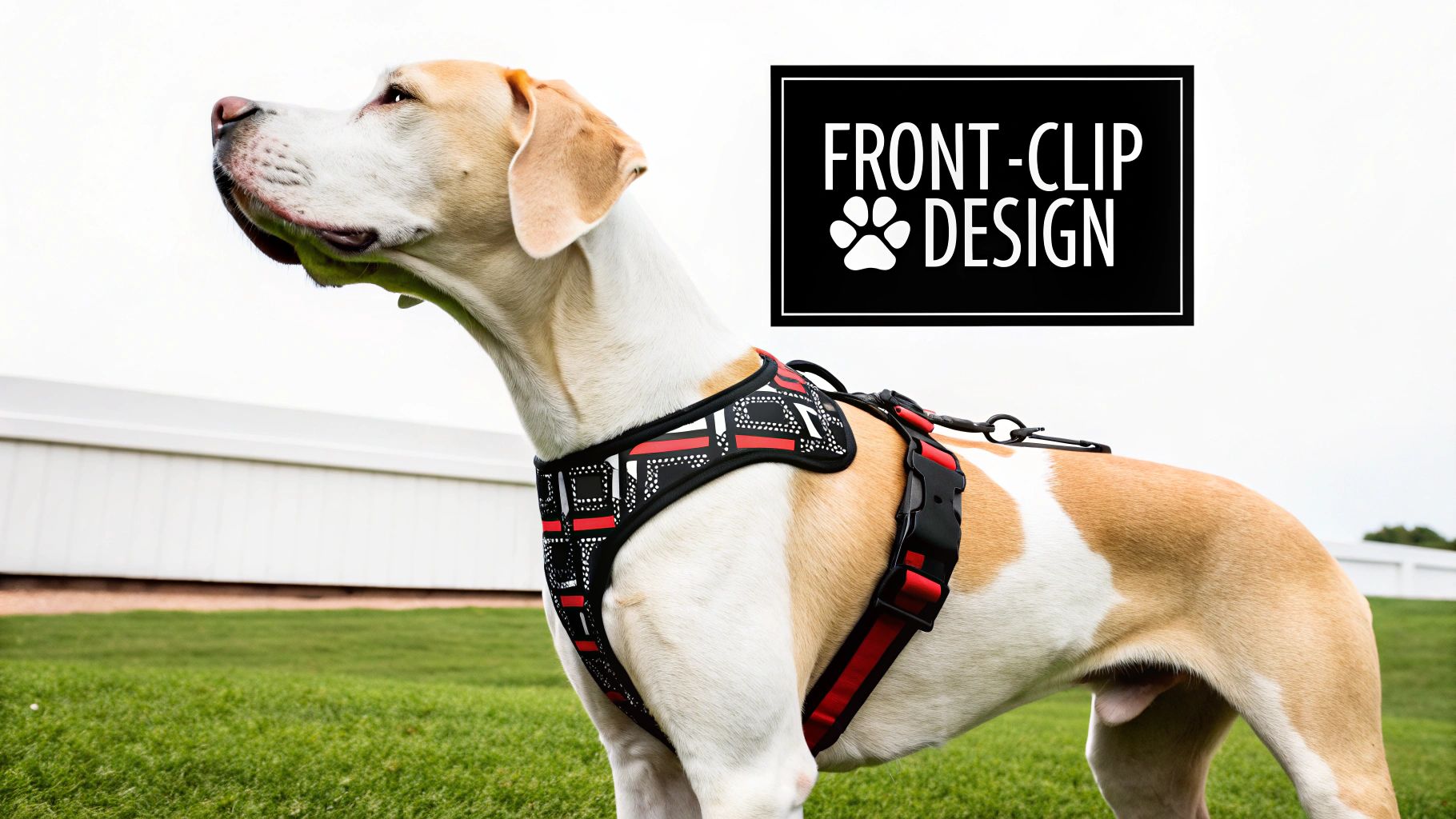
If you’ve ever felt like your arm is about to pop out of its socket on a walk, you know the frustration of a pulling dog. But to fix the problem, you have to understand it first. Your dog isn’t being stubborn or trying to dominate you—they’re just following their instincts.
It all comes down to something called the opposition reflex. This is a dog’s hardwired instinct to push back against pressure. When you pull back on a standard collar, what does your dog do? They dig in and pull even harder. This reflex turns what should be a simple leash correction into an endless game of tug-of-war, with the collar essentially becoming a “go faster” button.
This is exactly where the simple genius of a dog harness for no pulling comes in. Instead of trying to fight your dog’s nature, it works with it.
The Mechanics of Redirection
A no-pull harness is cleverly designed to bypass that opposition reflex. The secret is the front-clip leash attachment, which sits right in the center of your dog’s chest.
Think about steering a runaway shopping cart. If you try to stop it by pulling on the handle from behind, it just keeps rolling. But if you get to the front and push on its side, what happens? It pivots and changes direction. That’s the same principle a front-clip harness uses.
When your dog tries to lunge forward, the leash doesn’t yank their neck. Instead, the pressure on their chest gently turns their body back toward you. This simple redirection stops their forward momentum in its tracks without any choking, yanking, or struggle.
It’s not about punishment. The harness works as a gentle, mechanical guide that communicates, “Pulling forward isn’t getting you anywhere. Let’s try walking next to me instead.”
A Smarter and Safer Approach
This redirection method isn’t just more effective; it’s a whole lot safer. By moving the pressure point away from the sensitive throat and neck, it distributes the force across your dog’s much stronger chest and shoulders.
This focus on safety and smarter design is why the market is booming. The global dog harness market is projected to hit USD 7.05 billion by 2031, with innovations like the front-clip harness leading the charge. You can find more data on this market growth and see how it reflects a shift in owner priorities.
More and more dog owners are realizing that better equipment leads to better walks. Once you understand the “why” behind your dog’s pulling, you can truly appreciate the smart, humane solution a good harness offers.
How To Choose The Right No-Pull Dog Harness
Picking the perfect no-pull dog harness can feel like a chore with so many options out there. But it really just comes down to knowing your dog. There’s no single “best” harness for everyone; the right one depends on your dog’s size, breed, personality, and just how much they love to pull.
Let’s break down what really matters.
Key Features To Look For
First up, pay close attention to the materials and overall build quality. You want something that’s going to last, so look for durable, all-weather fabrics like nylon webbing. Check the stitching, especially around the D-rings where the leash clips on—these are the high-stress points that need to be solid.
Comfort is just as important as durability. If the harness isn’t comfortable, your dog won’t want to wear it. Look for soft padding on the straps that sit across the chest and back to prevent any rubbing or chafing.
Most importantly, you need a harness that’s highly adjustable. A proper fit is everything. The harness needs to be snug enough that your dog can’t Houdini their way out of it, but not so tight that it restricts their movement. Look for at least four to five points of adjustment to get that perfect, custom fit. And for those of us who walk in the early morning or after sunset, reflective stitching is a simple safety feature that makes a huge difference.
Front-Clip vs. Dual-Clip Harnesses
No-pull harnesses generally fall into two main camps: front-clip and dual-clip. Knowing how each one works is the key to picking the right tool for the job.
- Front-Clip Harnesses: These are the classic, go-to no-pull design. They have a single leash attachment right in the center of the dog’s chest. When your dog pulls forward, the leash applies gentle pressure that turns them back toward you. It’s a simple but brilliant concept that quickly teaches a dog that pulling doesn’t get them where they want to go.
- Dual-Clip Harnesses: Think of these as the more versatile, multi-tool option. They have two leash clips: one on the chest (like a front-clip) and another on the back, right between the shoulders. This setup gives you flexibility. You can use the front clip when you’re actively training loose-leash walking and then switch to the back clip for more casual, off-leash-style strolls once they’ve learned the ropes. Some trainers even recommend a double-ended leash connected to both points for ultimate control over strong pullers.
It’s easy to think that just putting on a harness will magically stop pulling. But really, a harness is a tool for communication and safety. Its power comes from how it helps you redirect your dog’s focus and gently guide them back to you.
This infographic really drives home how much of a difference the right harness can make, showing real-world improvements in both pulling force and owner satisfaction.
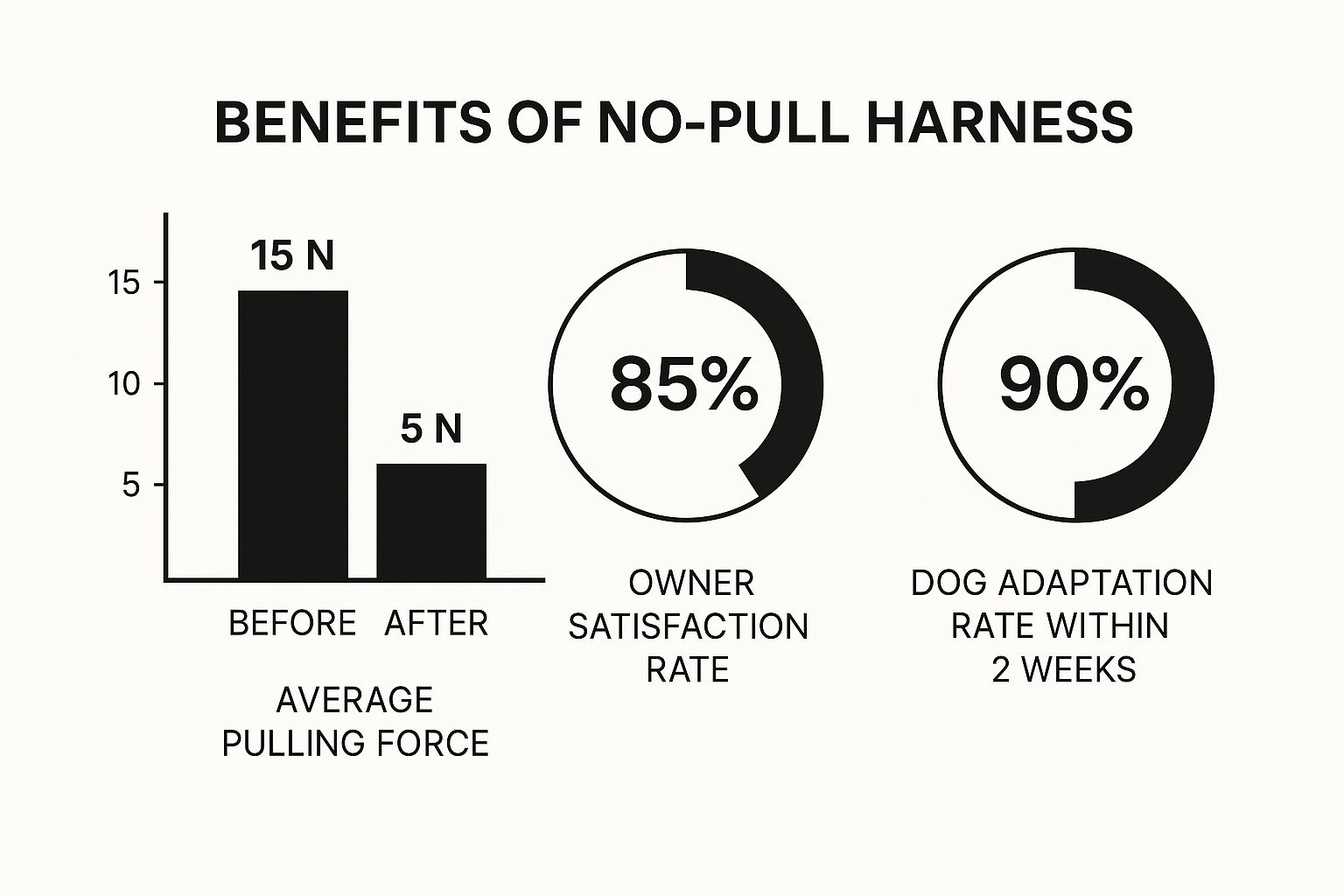
As you can see, the numbers show a massive drop in pulling and a big jump in successful training outcomes, proving just how valuable these harnesses are. This shift is reflected in the market, where you can discover more about the growing dog harness market and see how many owners are opting for more humane and effective training tools.
Comparing Front-Clip and Dual-Clip Harnesses
To help you decide, here’s a quick side-by-side look at the two most popular no-pull harness styles.
| Feature | Front-Clip Harness | Dual-Clip Harness |
|---|---|---|
| Primary Use | Training loose-leash walking, redirecting moderate pullers. | Versatile training and walking, suitable for all levels of pulling. |
| Control Level | Good. Gently redirects the dog’s forward momentum by turning them back to you. | Excellent. Offers both front-clip control and a standard back-clip option. |
| Best For | Dogs who are learning leash manners or are moderate pullers. | Strong pullers, training flexibility, and owners who want a single “do-it-all” harness. |
| Potential Drawbacks | The leash can sometimes get tangled in the dog’s front legs if there’s too much slack. | Can be slightly bulkier and may have more straps to adjust. |
Ultimately, the choice between a front-clip and a dual-clip harness depends on your dog and your training goals. For most dogs just starting out, a simple front-clip design is a fantastic tool. But if you have a really determined puller or just want more options, a dual-clip harness is a brilliant investment.
When you’re ready to find the right fit for your walking partner, feel free to explore our full collection of collars, leashes, and harnesses.
Getting the Fit and Introduction Just Right
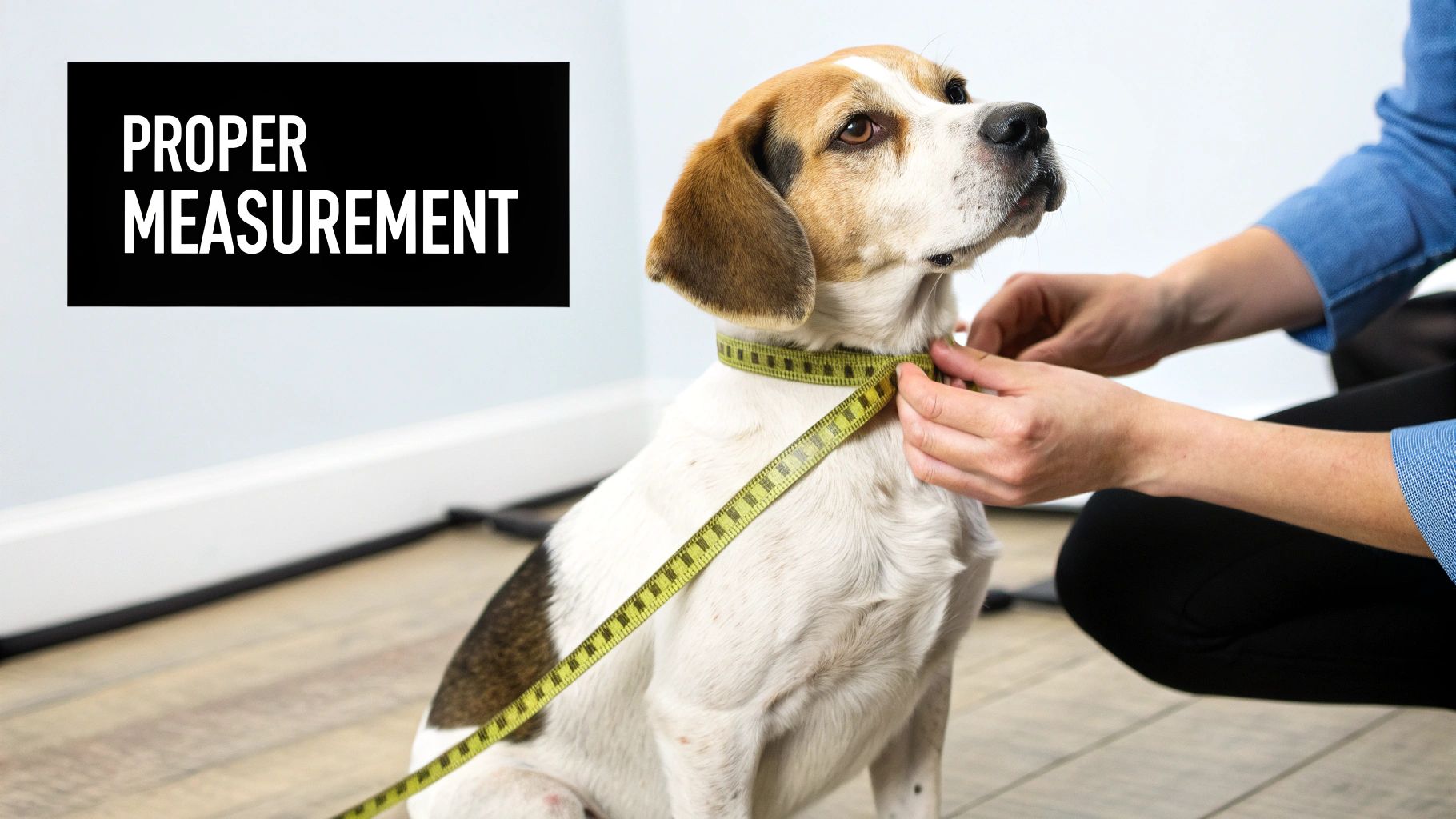
Here’s the truth: even the absolute best dog harness for no pulling on the market is totally useless if it doesn’t fit properly. A bad fit isn’t just a waste of money—it can cause painful chafing, restrict your dog’s natural movement, and even become a safety hazard if they slip out.
Getting the fit right is the single most important thing you can do to set your dog up for success on walks.
The sweet spot is a snug, secure fit that doesn’t pinch or slide around. A great rule of thumb I always recommend is the “two-finger rule.” Once the harness is on and buckled, you should be able to slide two fingers flat between any strap and your dog’s body. If there’s more room than that, it’s too loose. Can’t get two fingers in? It’s definitely too tight.
Achieving the Perfect Fit
Tightness is only half the battle; where the straps sit is just as critical. The harness needs to be positioned in a way that allows a full, natural range of motion, especially around those powerful shoulders.
- Chest Strap: Look for this strap to sit across the front of the chest (the breastbone), well above the shoulder points. It should never ride up and press on the throat.
- Back Strap: This piece should rest behind your dog’s front legs, comfortably on their rib cage. Make sure it’s far enough back that it won’t rub or chafe the sensitive skin in their “armpits.”
- Shoulder Freedom: A truly well-designed harness, like a quality tactical dog harness, often forms a “Y” shape over the chest. This is fantastic because it leaves the shoulder blades completely uncovered and free to move, which is vital for your dog’s comfort and long-term joint health.
Think of a correctly fitted harness as a piece of high-performance athletic gear. It provides the control and safety you need without ever getting in the way of your dog’s natural, fluid movement, keeping them comfortable and secure on every walk.
Making a Positive First Impression
How you introduce the harness can make all the difference. You want your dog to see it and think, “Yes! Fun and adventure!” not, “Oh no, not that thing.” The key is building a positive association from the get-go.
Take it slow. Start in a calm, quiet room and just let your dog sniff the new harness. Reward their curiosity with a tasty treat and some praise. You can even place it on the floor and give them a treat every time they interact with it.
Once they seem comfortable, gently slip the harness over their head, continuing with the treats and happy talk. Buckle it up, quickly check the fit, and then immediately do something they love. This could be a quick game of tug, a favorite toy, or better yet, heading straight out the door for that walk they’ve been waiting for. When you link the harness to good things, you teach them to love gearing up.
Effective Training with Your No-Pull Harness
It’s easy to think a no-pull dog harness is a magic wand, but it’s much better to see it for what it truly is: a powerful training tool. Think of it like a safety belt in a car—it’s an essential piece of equipment that makes the journey safer, but it doesn’t drive the car for you. The real transformation happens when you combine this smart gear with consistent, positive training.
The whole point is to teach your dog that walking calmly on a loose leash is way more rewarding than yanking you down the street. The harness is your assistant here. When your dog lunges forward, the front clip gently redirects their momentum, turning them back toward you. That’s your moment! The instant they turn and the leash goes slack, you praise them.
Building Good Habits from the Start
Your training should be all about rewarding the good stuff, not just correcting the bad. Don’t wait for your dog to pull to react. Instead, be on the lookout for those split seconds when the leash is loose, and jump on the opportunity to reward them with an enthusiastic “Yes!” and a treat they absolutely love.
The harness is really a communication device. It lets you interrupt the pulling cycle without yanking or scolding, creating a calm, teachable moment to show your dog exactly what you want.
This positive reinforcement approach does more than just fix pulling; it builds a stronger bond and teaches your dog that checking in with you is a great idea. The walk stops feeling like a battle and starts feeling like a team activity.
Simple Steps for Loose-Leash Success
Ready to get started? Here’s a simple routine to practice on your walks that really works.
- Start in a Low-Distraction Area: Your first few training sessions should be somewhere boring, like your yard or a quiet street. This helps your dog focus on you, not on squirrels, passing cars, or other dogs.
- Reward the “Check-In”: As you walk, give your dog a small, tasty treat every single time they’re beside you with a loose leash. They’ll quickly learn that the best spot on the walk is right next to you.
- Stop When They Pull: The second that leash goes tight, just stop walking. Stand completely still and quiet—become a tree. No yanking back, no scolding. Just wait.
- Praise the Release: The instant your dog turns back to you and the leash slackens, praise them warmly and immediately start walking again. This creates a crystal-clear connection: a loose leash makes the fun walk continue.
- Gradually Increase Distractions: Once your dog has this down in quiet areas, you can slowly start practicing in more challenging places.
Consistency is the name of the game. When you pair the gentle guidance of a no-pull harness with these simple, positive steps, you’re not just stopping an annoying habit. You’re building a foundation of teamwork that will give you years of happy, peaceful walks together.
Common Questions About No-Pull Dog Harnesses
Even with all the benefits, it’s totally normal to have a few questions before you switch over to a no-pull dog harness. Figuring out how these tools work and the best way to use them is the first step toward more confident, enjoyable walks for both of you.
Let’s clear up some of the most common concerns we hear from dog owners.
Are No-Pull Harnesses Cruel?
A big one we get asked all the time is about comfort and safety. Let’s set the record straight: when fitted correctly, a no-pull harness is one of the most humane walking tools you can find.
Unlike traditional collars that yank on a dog’s sensitive neck and throat, a harness spreads that pressure across their much stronger chest and shoulders. The redirection you get from a front-clip harness is a gentle nudge, not a harsh or painful correction. The whole idea is to guide, not to punish.
This is a world away from choke chains or prong collars, which depend on causing discomfort to stop the pulling. A well-designed harness gives you control without hurting your dog or damaging the trust you’ve built.
A no-pull harness is not a punishment tool. It’s a communication aid that helps you interrupt the pulling cycle and teach your dog that a loose leash is the best way to move forward, making walks more pleasant for everyone.
How Do I Use a Harness Correctly?
Another frequent question is whether a dog can just wear their harness all day. The short answer is, it’s really not a good idea. Think of the harness as special gear you put on specifically for walks and training time.
Leaving a harness on 24/7 can cause a few headaches:
- Skin Irritation: Constant wear can trap moisture and dirt against your dog’s skin, leading to chafing and other issues.
- Matted Fur: If you have a long-haired dog, you know the struggle. Straps left on for too long are a recipe for tangled, matted fur. (Keeping your pup’s coat in good shape is key, and our collection of grooming and cleaning supplies can help with that!)
- It Loses Its Magic: When the harness only comes out for walks, it becomes a powerful signal to your dog that an adventure is about to begin. If they wear it all the time, that special cue gets lost.
But what if your dog still pulls even with the harness on? First, double-check the fit. A harness that’s too loose won’t be able to do its job of redirecting them. Second, remember that it’s a training aid, not a magic wand. Reinforce the lesson by stopping in your tracks the moment the leash gets tight. The second they turn back and release that tension, heap on the praise. Consistency is what really makes the difference.
At Ur Pet Store, we believe the right gear can transform your training journey. Explore our collection of high-quality, comfortable no-pull harnesses and find the perfect fit to start enjoying peaceful walks with your best friend.

